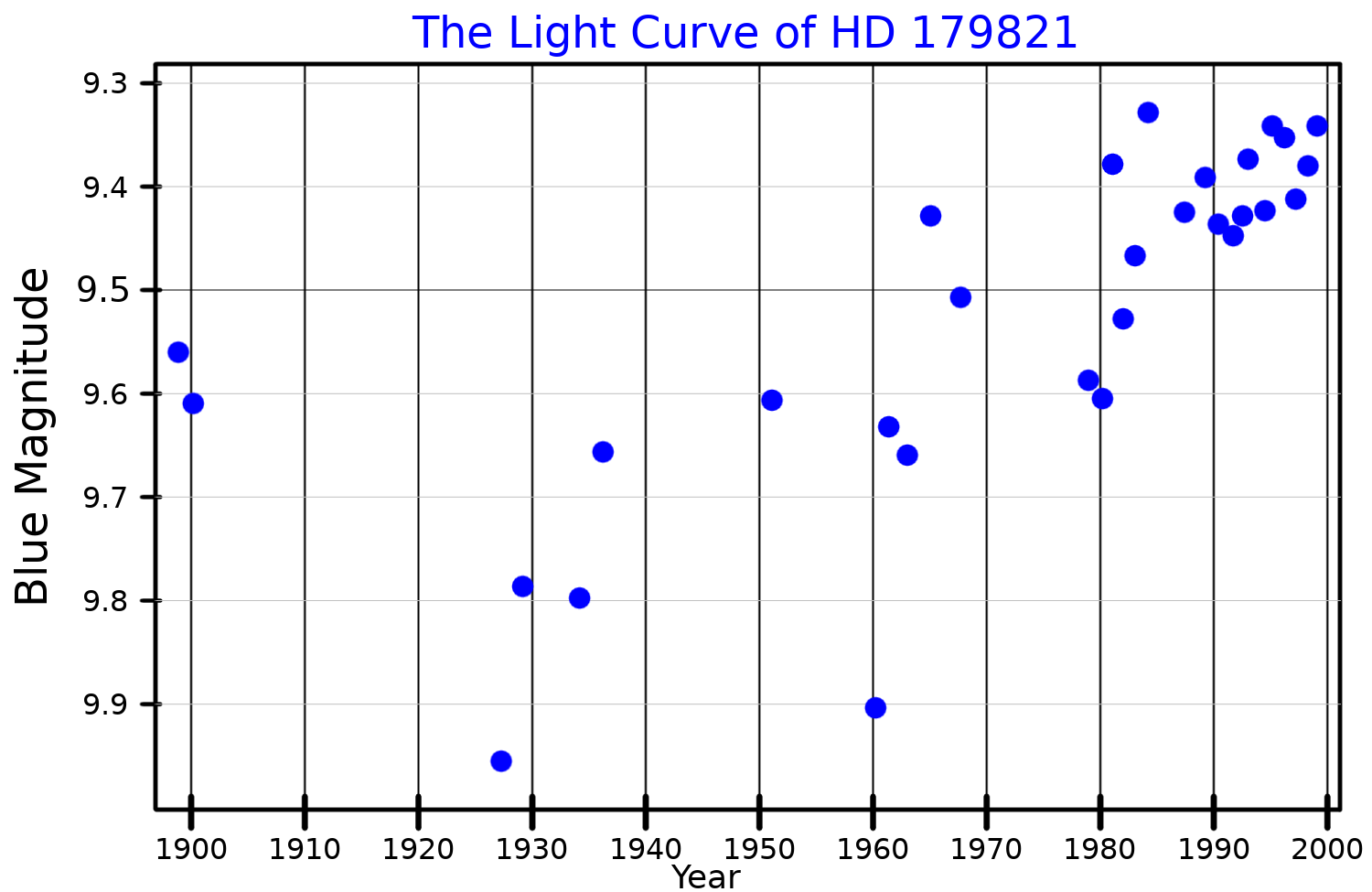|
HD 179821
HD 179821 or V1427 Aquilae is either a post-red supergiant yellow hypergiant or a post-AGB star, post-AGB yellow supergiant star in the constellation of Aquila (constellation), Aquila, surrounded by a detached dust shell. It is a semi-regular variable nearing the end of its life. Discovery HD 179821 was first catalogued as an unremarkable 8th magnitude star at the start of the 20th century. It was later listed as a spectral standard G4 0-Ia, indicating a highly luminous star type now known as a hypergiant. It was first considered notable for its infrared excess and double-peaked spectral energy distribution in the infrared. These were considered to be indicators of surrounding dust and HD 179821 was identified as a possible proto-planetary nebulae, proto-planetary nebula. Variability was also detected. High resolution spectroscopic studies and modern space-based observations have revealed an unusual chemical makeup and a hollow spherical dust shell, but haven't fully r ... [...More Info...] [...Related Items...] OR: [Wikipedia] [Google] [Baidu] |
HD 179821
HD 179821 or V1427 Aquilae is either a post-red supergiant yellow hypergiant or a post-AGB star, post-AGB yellow supergiant star in the constellation of Aquila (constellation), Aquila, surrounded by a detached dust shell. It is a semi-regular variable nearing the end of its life. Discovery HD 179821 was first catalogued as an unremarkable 8th magnitude star at the start of the 20th century. It was later listed as a spectral standard G4 0-Ia, indicating a highly luminous star type now known as a hypergiant. It was first considered notable for its infrared excess and double-peaked spectral energy distribution in the infrared. These were considered to be indicators of surrounding dust and HD 179821 was identified as a possible proto-planetary nebulae, proto-planetary nebula. Variability was also detected. High resolution spectroscopic studies and modern space-based observations have revealed an unusual chemical makeup and a hollow spherical dust shell, but haven't fully r ... [...More Info...] [...Related Items...] OR: [Wikipedia] [Google] [Baidu] |
Effective Temperature
The effective temperature of a body such as a star or planet is the temperature of a black body that would emit the same total amount of electromagnetic radiation. Effective temperature is often used as an estimate of a body's surface temperature when the body's emissivity curve (as a function of wavelength) is not known. When the star's or planet's net emissivity in the relevant wavelength band is less than unity (less than that of a black body), the actual temperature of the body will be higher than the effective temperature. The net emissivity may be low due to surface or atmospheric properties, including greenhouse effect. Star The effective temperature of a star is the temperature of a black body with the same luminosity per ''surface area'' () as the star and is defined according to the Stefan–Boltzmann law . Notice that the total (bolometric) luminosity of a star is then , where is the stellar radius. The definition of the stellar radius is obviously not straightf ... [...More Info...] [...Related Items...] OR: [Wikipedia] [Google] [Baidu] |
Visual Magnitude
Apparent magnitude () is a measure of the brightness of a star or other astronomical object observed from Earth. An object's apparent magnitude depends on its intrinsic luminosity, its distance from Earth, and any extinction of the object's light caused by interstellar dust along the line of sight to the observer. The word ''magnitude'' in astronomy, unless stated otherwise, usually refers to a celestial object's apparent magnitude. The magnitude scale dates back to the ancient Roman astronomer Claudius Ptolemy, whose star catalog listed stars from 1st magnitude (brightest) to 6th magnitude (dimmest). The modern scale was mathematically defined in a way to closely match this historical system. The scale is reverse logarithmic: the brighter an object is, the lower its magnitude number. A difference of 1.0 in magnitude corresponds to a brightness ratio of \sqrt /math>, or about 2.512. For example, a star of magnitude 2.0 is 2.512 times as bright as a star of magnitude 3.0, ... [...More Info...] [...Related Items...] OR: [Wikipedia] [Google] [Baidu] |
Apparent Magnitude
Apparent magnitude () is a measure of the brightness of a star or other astronomical object observed from Earth. An object's apparent magnitude depends on its intrinsic luminosity, its distance from Earth, and any extinction of the object's light caused by interstellar dust along the line of sight to the observer. The word ''magnitude'' in astronomy, unless stated otherwise, usually refers to a celestial object's apparent magnitude. The magnitude scale dates back to the ancient Roman astronomer Claudius Ptolemy, whose star catalog listed stars from 1st magnitude (brightest) to 6th magnitude (dimmest). The modern scale was mathematically defined in a way to closely match this historical system. The scale is reverse logarithmic: the brighter an object is, the lower its magnitude number. A difference of 1.0 in magnitude corresponds to a brightness ratio of \sqrt /math>, or about 2.512. For example, a star of magnitude 2.0 is 2.512 times as bright as a star of magnitude 3.0, 6. ... [...More Info...] [...Related Items...] OR: [Wikipedia] [Google] [Baidu] |
Variable Star Designation
In astronomy, a variable star designation is a unique identifier given to variable stars. It uses a variation on the Bayer designation format, with an identifying label (as described below) preceding the Latin genitive of the name of the constellation in which the star lies. See List of constellations for a list of constellations and the genitive forms of their names. The identifying label can be one or two Latin letters or a ''V'' plus a number (e.g. V399). Examples are R Coronae Borealis, YZ Ceti, V603 Aquilae. Naming The current naming system is: *Stars with existing Greek letter Bayer designations are not given new designations. *Otherwise, start with the letter R and go through Z. *Continue with RR...RZ, then use SS...SZ, TT...TZ and so on until ZZ. *Use AA...AZ, BB...BZ, CC...CZ and so on until reaching QZ, omitting J in both the first and second positions.Most of this system was invented in Germany, which was still on Fraktur at the time, in which the majuscules "I" and ... [...More Info...] [...Related Items...] OR: [Wikipedia] [Google] [Baidu] |
Monthly Notices Of The Royal Astronomical Society
''Monthly Notices of the Royal Astronomical Society'' (MNRAS) is a peer-reviewed scientific journal covering research in astronomy and astrophysics. It has been in continuous existence since 1827 and publishes letters and papers reporting original research in relevant fields. Despite the name, the journal is no longer monthly, nor does it carry the notices of the Royal Astronomical Society. History The first issue of MNRAS was published on 9 February 1827 as ''Monthly Notices of the Astronomical Society of London'' and it has been in continuous publication ever since. It took its current name from the second volume, after the Astronomical Society of London became the Royal Astronomical Society (RAS). Until 1960 it carried the monthly notices of the RAS, at which time these were transferred to the newly established ''Quarterly Journal of the Royal Astronomical Society'' (1960–1996) and then to its successor journal ''Astronomy & Geophysics'' (since 1997). Until 1965, MNRAS ... [...More Info...] [...Related Items...] OR: [Wikipedia] [Google] [Baidu] |
Nebula
A nebula ('cloud' or 'fog' in Latin; pl. nebulae, nebulæ or nebulas) is a distinct luminescent part of interstellar medium, which can consist of ionized, neutral or molecular hydrogen and also cosmic dust. Nebulae are often star-forming regions, such as in the "Pillars of Creation" in the Eagle Nebula. In these regions, the formations of gas, dust, and other materials "clump" together to form denser regions, which attract further matter, and eventually will become dense enough to form stars. The remaining material is then thought to form planets and other planetary system objects. Most nebulae are of vast size; some are hundreds of light-years in diameter. A nebula that is visible to the human eye from Earth would appear larger, but no brighter, from close by. The Orion Nebula, the brightest nebula in the sky and occupying an area twice the angular diameter of the full Moon, can be viewed with the naked eye but was missed by early astronomers. Although denser than the space ... [...More Info...] [...Related Items...] OR: [Wikipedia] [Google] [Baidu] |
Reflection Nebula
Reflection or reflexion may refer to: Science and technology * Reflection (physics), a common wave phenomenon ** Specular reflection, reflection from a smooth surface *** Mirror image, a reflection in a mirror or in water ** Signal reflection, in signal transmission * Elastic scattering, a process in nuclear and particle physics * Reflection nebula, a nebula that is extended and has no boundaries * Reflection seismology or seismic reflection, a method of exploration geophysics Mathematics * Reflection principle, in set theory * Point reflection, a reflection across a point * Reflection (mathematics), a transformation of a space * Reflection formula, a relation in a function * Reflective subcategory, in category theory Computing * Reflection (computer graphics), simulation of reflective surfaces * Reflection (computer programming), a program that accesses or modifies its own code * Reflection, terminal emulation software by Attachmate Arts and entertainment Film and television * ... [...More Info...] [...Related Items...] OR: [Wikipedia] [Google] [Baidu] |
IRC +10420
IRC+10420, also known as V1302 Aql, is a yellow hypergiant star located in the constellation of Aquila at a distance of 4-6 kiloparsecs of the Sun. Discovery IRC+10420 was first identified in the 1969 Infrared Catalogue of 2.2 micron sources. It was quickly noted as a very unusual object after being detected at 20 microns as one of the brightest sources in the sky with a large infrared excess, and was compared to Eta Carinae during one of its outbursts. It was also discovered to be a strong source of OH maser emission. It was formally catalogued as variable star V1302 Aquilae. Identification on historical photographic plates showed possible irregular variations of about a magnitude before 1925, followed by a smooth gradual increase in brightness from magnitude 15 to brighter than magnitude 14 by 1976. Some authors had grouped IRC+10420 with the proto-planetary nebulae because of the surrounding nebulosity, but it was widely recognised as a highly luminous supergia ... [...More Info...] [...Related Items...] OR: [Wikipedia] [Google] [Baidu] |
VY Canis Majoris
VY Canis Majoris (abbreviated to VY CMa) is an extreme oxygen-rich (O-rich) red hypergiant (RHG) or red supergiant (RSG) and pulsating variable star from the Solar System in the slightly southern constellation of Canis Major. It is one of the largest known stars, one of the most luminous and massive red supergiants, and one of the most luminous stars in the Milky Way. No evidence has been found that it is part of a multiple star system. Its great infrared (IR) excess makes it one of the brightest objects in the local part of the galaxy at wavelengths of 5 to 20 microns (µm) and indicates a dust shell or heated disk. It is about times the mass of the Sun (). It is surrounded by a complex asymmetric circumstellar envelope (CSE) caused by its mass loss. It produces strong molecular maser emission and was one of the first radio masers discovered. VY CMa is embedded in the large molecular cloud Sh2-310, a large, quite local star-forming H II region—its diameter: 48 ... [...More Info...] [...Related Items...] OR: [Wikipedia] [Google] [Baidu] |







